Page List


Published in 2016 by The Rosen Publishing Group, Inc. 29 East 21st Street, New York, NY 10010 Copyright 2016 by The Rosen Publishing Group, Inc. All rights reserved. No part of this book may be reproduced in any form without permission in writing from the publisher, except by a reviewer. First Edition Editor: Caitie McAneney Book Design: Mickey Harmon Photo Credits: Cover (image) nico99/Shutterstock.com; cover, pp. 5 MarkMirror/Shutterstock.com; p. 7 Joel Sartore/National Geographic/Getty Images; pp. 9, 16 Audrey Snider-Bell/Shutterstock.com; p. 10 basel101658/Shutterstock.com; p. 13 (spitting spider) Stephen Dalton/Minden Pictures/Getty Images; p. 13 (jumping spider) skynetphoto/Shutterstock.com; p. 13 (bolus spider) Auscape/Contributor/Universal Images Group/Getty Images; pp. 1415 (main) Cathy Keifer/Shutterstock.com; p. 14 (inset) Calvste/Shutterstock.com; p. 17 Sandra Caldwell/Shutterstock.com; p. 19 Jorg Hackemann/Shutterstock.com; pp. 2021 (main) symbiot/Shutterstock.com; p. 21 (inset) Ainars Aunins/Shutterstock.com; p. 22 Hector Ruiz Villar/Shutterstock.com. 22 Hector Ruiz Villar/Shutterstock.com.
Library of Congress Cataloging-in-Publication Data Shea, Therese, author. We need spiders / Therese Shea. pages cm. (Creatures we cant live without) Includes bibliographical references and index. ISBN 978-1-4994-0984-0 (pbk.) ISBN 978-1-4994-1026-6 (6 pack) ISBN 978-1-4994-1044-0 (library binding) 1. I. Title. II. II.
Series: Creatures we cant live without. QL458.4.S535 2015 595.44dc23 2015012087 Manufactured in the United States of America CPSIA Compliance Information: Batch #WS15PK: For Further Information contact Rosen Publishing, New York, New York at 1-800-237-9932 CONTENTS What do you do when you see a spider? Most people jump away or at least back up slowly. Then, they think about whether to kill the spider or place it far away from them. Did you ever think about just leaving the spider alone? Spiders are actually very useful to people. Of course, they dont know it, but just by living their lives, spiders help us. They eat insects, other arachnids, and small creatures, which helps keep some animal populations under control.
Without spiders, we might be overrun by flies, mosquitoes, and other pests that are much more unpleasant to live with. CREATURE CLUE There are more than 43,000 species, or kinds, of spiders.  Spiders are helpful to us in some surprising ways. Theyve been on Earth longer than peopleabout 400 million years! Perhaps so many people are afraid of spiders because of their appearance. They seem creepy because they look so different from creatures we think are cute and cuddly. Like other arachnids, spiders have eight legs and a body divided into two parts: the abdomen (stomach) and the cephalothorax (head and torso).
Spiders are helpful to us in some surprising ways. Theyve been on Earth longer than peopleabout 400 million years! Perhaps so many people are afraid of spiders because of their appearance. They seem creepy because they look so different from creatures we think are cute and cuddly. Like other arachnids, spiders have eight legs and a body divided into two parts: the abdomen (stomach) and the cephalothorax (head and torso).
If thats not creepy enough, most spiders have eight eyes placed in rows on their head. Some have six or fewer eyes, though. Strangely, even with all these eyes, most spiders dont have good eyesight. They have different ways of catching prey than using their sense of sight. CREATURE CLUE Spiders are often called insects, but theyre not. 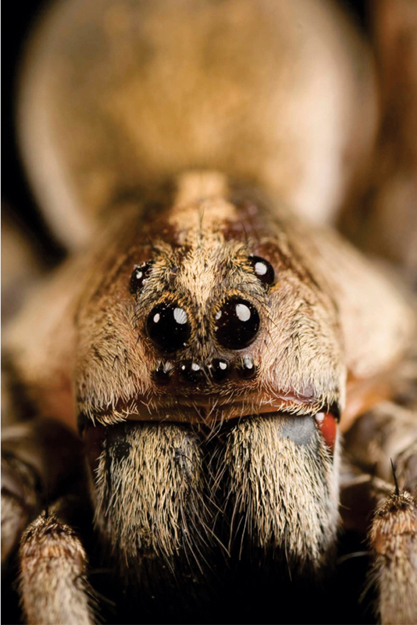 This wolf spider has eight eyes, but some spiders that live in dark caves have no eyes! Many people are scared of spiders because of their venom, or poison.
This wolf spider has eight eyes, but some spiders that live in dark caves have no eyes! Many people are scared of spiders because of their venom, or poison.  This wolf spider has eight eyes, but some spiders that live in dark caves have no eyes! Many people are scared of spiders because of their venom, or poison.
This wolf spider has eight eyes, but some spiders that live in dark caves have no eyes! Many people are scared of spiders because of their venom, or poison.
However, very few species make venom that can harm people. The black widow, brown recluse, and Brazilian wandering spider are three spiders with venomous bites. Spider bites arent usually deadly. Scientists think spider venom could have important uses in medicine. Scientists at the University at Buffalo are studying how the venom of the Chilean rose tarantula might be able to treat muscular dystrophy. People with muscular dystrophy have muscles that get weaker over time until they stop working.
Venom may be the answer to helping these people live longer and healthier lives. CREATURE CLUE Some scientists believe spider venom can be used for pain-killers. 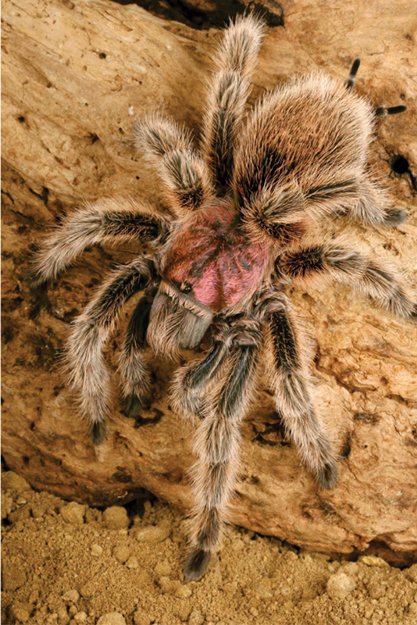 The Chilean rose tarantula is a popular pet spider. It has hair all over its body.
The Chilean rose tarantula is a popular pet spider. It has hair all over its body. 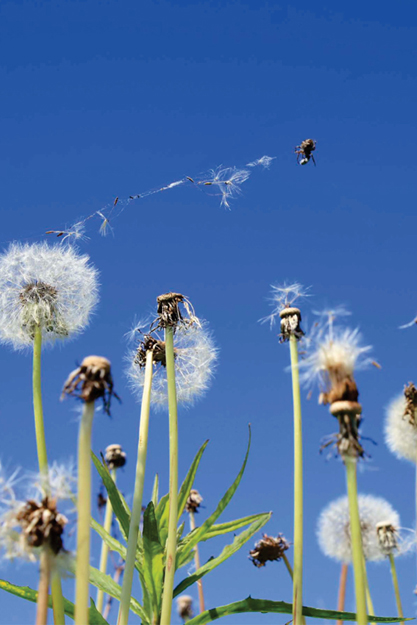 Spiders usually live and hunt alone. Some use ballooning, or being carried by the wind while attached to a long piece of silk, to find new surroundings and more food.
Spiders usually live and hunt alone. Some use ballooning, or being carried by the wind while attached to a long piece of silk, to find new surroundings and more food.
Some people think spiders are the most important insect predator, so its a good thing theyre found everywhere! Spiders are found on every continent in the world except Antarctica. Most live on land, but at least one species makes its home in water. Many spider species prefer tropical areas to cooler areas. However, some spiders are found high in the mountains where its very cold. Tropical areas are home to many different kinds of bugs. CREATURE CLUE The cane spider is found in many tropical regions of the world. CREATURE CLUE The cane spider is found in many tropical regions of the world.
Its responsible for eating many bugs in its warm, wet surroundings. Scientists divide spiders into groups based on their hunting methods: those that actively hunt and those that build webs. Hunting spiders have good eyesight that they use to spot their prey. Jumping spiders leap great distances right onto their prey. Web-building spiders usually dont see well. They build silk webs that trap prey and carry their vibrations to the spider.
Orb weavers make a circular web that flying insects dont see until theyre stuck in it. Bolas spiders let out one thread with a sticky drop at the end. They wait for prey to walk into it or even swing it at prey. CREATURE CLUE Trap-door spiders wait under the ground until they feel vibrations above. Then they attack!  Spitting spiders are hunting spiders.
Spitting spiders are hunting spiders. 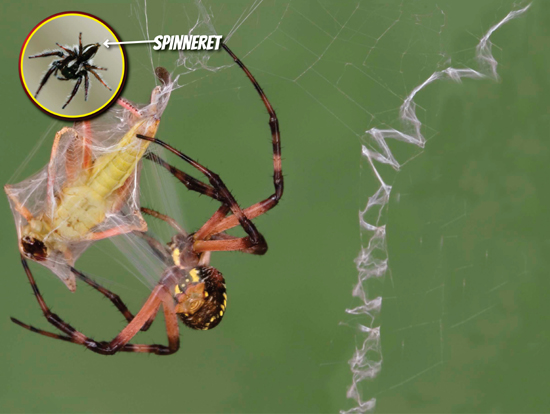 Web-making spiders use sticky and nonsticky silk in their webs.
Web-making spiders use sticky and nonsticky silk in their webs.  Web-making spiders use sticky and nonsticky silk in their webs.
Web-making spiders use sticky and nonsticky silk in their webs.
They know to walk on the nonsticky silk. A spider lets out silk from body parts called spinnerets. It wraps its prey in silk, turning the prey as it works. Then the spider may carry the prey somewhere until its ready to eat. Most spiders make more than one kind of silk in their abdomen. They have different uses for different silk, such as wrapping their eggs and making a nest.

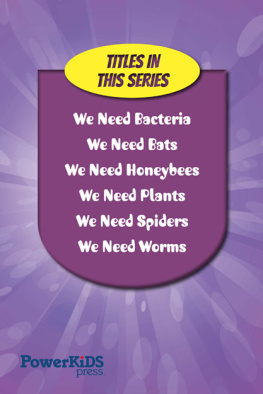






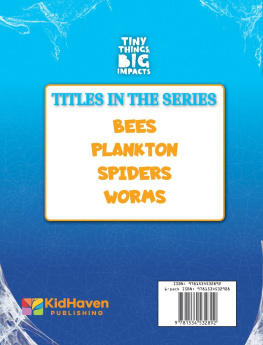
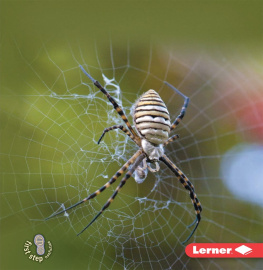
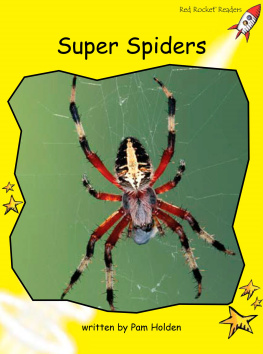

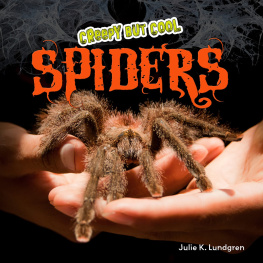


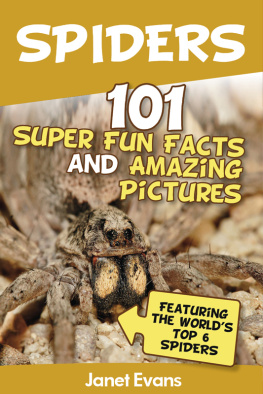
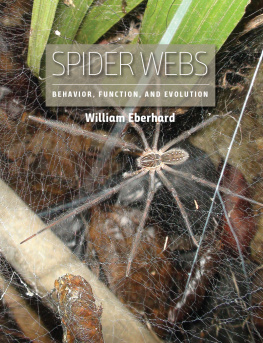


 Published in 2016 by The Rosen Publishing Group, Inc. 29 East 21st Street, New York, NY 10010 Copyright 2016 by The Rosen Publishing Group, Inc. All rights reserved. No part of this book may be reproduced in any form without permission in writing from the publisher, except by a reviewer. First Edition Editor: Caitie McAneney Book Design: Mickey Harmon Photo Credits: Cover (image) nico99/Shutterstock.com; cover, pp. 5 MarkMirror/Shutterstock.com; p. 7 Joel Sartore/National Geographic/Getty Images; pp. 9, 16 Audrey Snider-Bell/Shutterstock.com; p. 10 basel101658/Shutterstock.com; p. 13 (spitting spider) Stephen Dalton/Minden Pictures/Getty Images; p. 13 (jumping spider) skynetphoto/Shutterstock.com; p. 13 (bolus spider) Auscape/Contributor/Universal Images Group/Getty Images; pp. 1415 (main) Cathy Keifer/Shutterstock.com; p. 14 (inset) Calvste/Shutterstock.com; p. 17 Sandra Caldwell/Shutterstock.com; p. 19 Jorg Hackemann/Shutterstock.com; pp. 2021 (main) symbiot/Shutterstock.com; p. 21 (inset) Ainars Aunins/Shutterstock.com; p. 22 Hector Ruiz Villar/Shutterstock.com. 22 Hector Ruiz Villar/Shutterstock.com.
Published in 2016 by The Rosen Publishing Group, Inc. 29 East 21st Street, New York, NY 10010 Copyright 2016 by The Rosen Publishing Group, Inc. All rights reserved. No part of this book may be reproduced in any form without permission in writing from the publisher, except by a reviewer. First Edition Editor: Caitie McAneney Book Design: Mickey Harmon Photo Credits: Cover (image) nico99/Shutterstock.com; cover, pp. 5 MarkMirror/Shutterstock.com; p. 7 Joel Sartore/National Geographic/Getty Images; pp. 9, 16 Audrey Snider-Bell/Shutterstock.com; p. 10 basel101658/Shutterstock.com; p. 13 (spitting spider) Stephen Dalton/Minden Pictures/Getty Images; p. 13 (jumping spider) skynetphoto/Shutterstock.com; p. 13 (bolus spider) Auscape/Contributor/Universal Images Group/Getty Images; pp. 1415 (main) Cathy Keifer/Shutterstock.com; p. 14 (inset) Calvste/Shutterstock.com; p. 17 Sandra Caldwell/Shutterstock.com; p. 19 Jorg Hackemann/Shutterstock.com; pp. 2021 (main) symbiot/Shutterstock.com; p. 21 (inset) Ainars Aunins/Shutterstock.com; p. 22 Hector Ruiz Villar/Shutterstock.com. 22 Hector Ruiz Villar/Shutterstock.com.  Spiders are helpful to us in some surprising ways. Theyve been on Earth longer than peopleabout 400 million years! Perhaps so many people are afraid of spiders because of their appearance. They seem creepy because they look so different from creatures we think are cute and cuddly. Like other arachnids, spiders have eight legs and a body divided into two parts: the abdomen (stomach) and the cephalothorax (head and torso).
Spiders are helpful to us in some surprising ways. Theyve been on Earth longer than peopleabout 400 million years! Perhaps so many people are afraid of spiders because of their appearance. They seem creepy because they look so different from creatures we think are cute and cuddly. Like other arachnids, spiders have eight legs and a body divided into two parts: the abdomen (stomach) and the cephalothorax (head and torso). This wolf spider has eight eyes, but some spiders that live in dark caves have no eyes! Many people are scared of spiders because of their venom, or poison.
This wolf spider has eight eyes, but some spiders that live in dark caves have no eyes! Many people are scared of spiders because of their venom, or poison.  The Chilean rose tarantula is a popular pet spider. It has hair all over its body.
The Chilean rose tarantula is a popular pet spider. It has hair all over its body.  Spiders usually live and hunt alone. Some use ballooning, or being carried by the wind while attached to a long piece of silk, to find new surroundings and more food.
Spiders usually live and hunt alone. Some use ballooning, or being carried by the wind while attached to a long piece of silk, to find new surroundings and more food. Spitting spiders are hunting spiders.
Spitting spiders are hunting spiders.  Web-making spiders use sticky and nonsticky silk in their webs.
Web-making spiders use sticky and nonsticky silk in their webs.